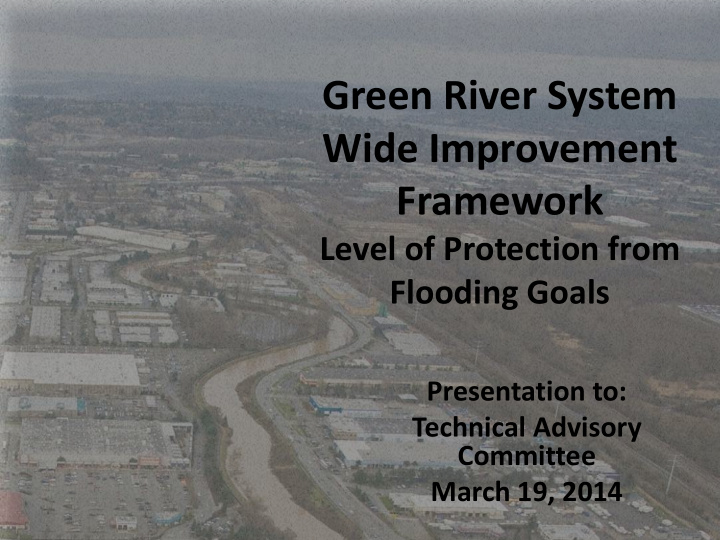



Green River System Wide Improvement Framework Level of Protection from Flooding Goals Presentation to: Technical Advisory Committee March 19, 2014
PRESENTATION OUTCOMES • Improved understanding regarding Level of Protection from flooding goals and goal setting process for Lower Green River facilities • Timeline/process for Level of Protection goal setting 1936 2
What is Level of Protection? DEFINITION • Level of Protection (LOP) is the amount of flow, expressed as cubic feet per second (cfs), that is expected to be contained within a specific portion of the river channel • LOP goals will be established by the Flood Control District for the Lower Green River shoreline, at a reach scale • SWIF advisors will inform Lower Green River LOP goal setting Desimone Levee, 2009 Galli Levee, 2013 3
Why are Level of Protection Goals Needed? • Current Level of Protection varies along the Lower Green River • There is a lack of agreement on the desired or necessary LOP to protect current land uses from flooding • Level of Protection goals Lower Green River Valley, 1959 will inform future: – Budget decisions – Investment options – Rate of Capital program implementation 4
How will Level of Protection Goals Inform the Green River SWIF? • Alternatives analysis – SWIF alternatives to meet LOP goals • Capital projects – Priority SWIF projects will be designed to achieve LOP goals Kent Shops Narita, 2009 • SWIF implementation – LOP goals will guide SWIF implementation over time 5
Lower Green River Shoreline Statistics 42 miles total of Lower Green River shoreline 16 miles of levees, enrolled in PL84-99 12 miles of non-PL84- 99 levees/ revetments 14 miles of shoreline with no facilities 6
Lower Green River Flood Facility Types Levees and Reve tments 7
Lower Green River Level of Protection Goal Options Three LOP goal options to be applied to the Lower Green River shoreline: A. Maintain current condition or Level of Protection (LOP) B. Increase LOP C. Achieve maximum LOP of X cubic feet per second (cfs), (where X = 15,000 - 18,800 cfs?? - TBD) 8
Lower Green River Level of Protection Goal Maps Three LOP maps* will be prepared for the Lower Green River to inform goal setting discussions: Map 1. Mix of LOP options ‘A’, ‘B’, and ‘C’ Map 2. Mix of LOP options ‘A’ and ‘C’ only Map 3. LOP option ‘C’ everywhere * Each LOP map will be accompanied by a rough cost estimate 9
What Will Inform Level of Protection Goals? • Flood risk assessment (forthcoming April/May 2014) and evaluation of other technical information – Evaluation of variable flow rates (12,000; 15,000; 18,800 and 26,000 cfs – as directed by FCD) – Levee Overtopping and breaching risks, and levee failure scenarios – Floodplain inundation and depth maps – Expected annual damages and present value tables • SWIF TAC and Advisory Council • Flood Control District approval – June 2014 10
Green River System Wide Improvement Framework Level of Protection Goal Setting Timeline Task Date FCD approves provisional range of 12,000 cfs to 26,800 cfs – to January 2014 guide flood risk assessment KC FCD Executive Committee informational briefing March 5, 2014 Introduce LOP goal setting to SWIF Technical Advisory Committee March 19, 2014 Current Conditions Symposium for TAC and AC, including flood risk April 16, 2014 assessment results Technical Advisory Committee recommends maximum LOP and May 2014 preferred LOP goals (map) to AC • (April 2014) Advisory Council recommends maximum LOP and preferred LOP Early June 2014 goals (map) to FCD FCD Executive Committee establishes LOP goals (map) Late June 2014 Prepare SWIF alternatives analysis to reflect LOP goals Summer/Fall 2014 Generate prioritized CIPs needed to achieve LOP goals Late Fall 2014 11
Questions? 12
Level of Protection – “500 - yr” Levees 13
Lower Green Flood Flow Frequencies Teeing up “Level of Protection” Issue Discharge (cubic feet per second) 10-year 50-year 100-year 500-year (10% annual (2% annual (1% annual (0.2% annual Location chance) chance) chance) chance) USGS Auburn Gage 12,000 12,000 12,000 12,000 (2005 Flood Insurance Study) Reach 3 (near Auburn 11,230 12,420 12,810 13,460 gage) (2010 pDFIRM) Reddington Levee Setback 11,200 12,300 12,500 14,900 (Tetra Tech et al., 2011) USGS gage (USACE 2012, 12,000 12,000 12,000 18,800 Assembly of Design Flood Hydrographs) - Median Lower Confidence Limit 11,900 12,000 12,000 12,000 (95%) Upper Confidence Limit 12,000 12,000 15,100 26,800 (5%) 14
Flood Risk Tolerance What is the probability of exceeding a design flow over different timeframes? Green SWIF will be tackling this challenging question….. 30 Years 50 Years 75 Years 100 Years 1:100 (aka ‘the 100 -year 26% 39% 53% 63% flood) 1:140 ( current USACE estimate 19% 30% 42% 51% of Green River flood control) 1:200 14% 22% 31% 39% 1:300 10% 15% 22% 28% 1:500 6% 10% 14% 18% 15
Recommend
More recommend